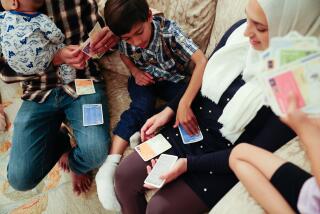Season’s greetings from the whimsy family
- Share via
Many families send out holiday cards that are essentially family portraits -- parents and children in various degrees of matching velvets and plaids posed somewhere meant to invoke the season. If collected over the years, such cards would chronicle the various changes time grants, and inflicts, on people -- children multiply and grow, adults experiment with hairstyles, colors and silhouettes.
Nick Spark’s family Christmas cards show all of these things, but they go way beyond that. A collection of the Spark family cards, more than 30 years’ worth, captures not only what is clearly a shared, and slightly odd, passion for artistic expression among the family, but also the vagaries of American popular culture.
Consider this year’s model. The panoramic-sized card is covered with images of people standing in a gallery -- on the back are words that appear to be German. At first glance, this seems to be a wacky announcement for a gallery opening somewhere in Germany. A closer inspection reveals that the dozen figures in the gallery are actually just two women and three men -- Nick, his parents, Marcia and Ron, his sister Marie and her husband. Upon even closer inspection, the pictures they are looking at turn out to be images of themselves, the photographs that they sent out as Christmas cards in years past.
The language on the back is not really German, it’s just sort of German-ized. “Derolidaycardenspeigel des Americanskava Familiansprache Sparksenbragel”, it begins.
Happy Holidays from the Sparks.
“I wanted to go with a German expressionism theme this year,” says Spark, a filmmaker and photographer who lives in Santa Monica. “It’s a 30-year retrospective of our Christmas cards.”
And not a snowman or tartan waistcoat in sight. There are Victorian costumes and cowboy get-ups; there are color themes -- red, white and blue; black and white checks -- there’s the waiters-at-the-Last Supper image; several quilt-heavy hippie shots from the early years; a rocket ship; an electric plant; there’s even a staged garage sale that includes the members of Marie’s wedding party. The pictures unconsciously mirror many trends in American culture -- down to Y2K paranoia -- but if you’re looking for the Claus clan, you’ll have to consult a different family.
“We’re all very visual people,” says Marcia Spark, who lives with her husband, Ron, in Tucson. “And a little eccentric. But now there are a lot of people who collect the cards, who wait to see what the next year will be.”
At one point, she said, they were sending out 500 cards a year. “We had to pare down a little; we didn’t even know some of these people. They just got on our list because they wanted the cards.”
Appropriately enough, this shared family obsession began with Sigmund Freud. In 1967, newlyweds Marcia and Ron were strolling through the Society Hill open market in Philadelphia when they saw an indigent photographer, armed with a Polaroid and a few props, turn a local psychiatrist into Freud. The Sparks donned a bonnet and a hat and haven’t bought commercial cards since.
As the family reputation grew, so did the pressure. “We plan for months in advance,” says Nick. “The black-and-white check image, it took like nine months to collect all the stuff.”
The kids loved it when they were little, hated it when they were adolescents and love it again now that they’re adults. They ran into a little trouble when Marie married her high school sweetheart, Mohan Vemulapalli. In his debut card -- the garage sale scene -- he looks a tad nonplused, perhaps because they staged the photo the morning after the wedding. And although Vemulapalli had received plenty of cards from the Sparks, he wasn’t quite prepared to take part in the staging of strange scenes in public places.
“Getting the cards,” says Nick, “is very different from being in them.”
One recent card included several shots in front of Seattle landmarks, and as the Sparks were taking their picture, a tour bus stopped and started taking pictures of them. “Mohan just lost it,” says Nick. “It was really touch and go, but now he’s down with it.”
For years now, the process of conceptualizing has been a democratic one, so it doesn’t always go smoothly. “Sometimes, if people don’t agree, it can get down to the wire,” says Nick. Meaning that the possibility of store-bought cards loomed in the middle distance? “Yeah,” he says, gulping audibly, “some years it’s been really, really scary.”
This year’s image was Nick’s idea and it was a hard sell. All the previous cards had been done by simply staging a scene and getting a family friend to shoot it. This year’s was the first done digitally -- Nick shot a gallery space and the old cards, and a friend shot the family posing looking at nothing. “When he told us about it, none of us could see it,” says Marcia. “But we just trusted Nick, and really, we are very excited about it.”
Nick, whose non-Christmas-card work focuses on popular culture, is also excited about going digital.
“Now,” he says, “we can do pretty much anything.”
More to Read
The biggest entertainment stories
Get our big stories about Hollywood, film, television, music, arts, culture and more right in your inbox as soon as they publish.
You may occasionally receive promotional content from the Los Angeles Times.











